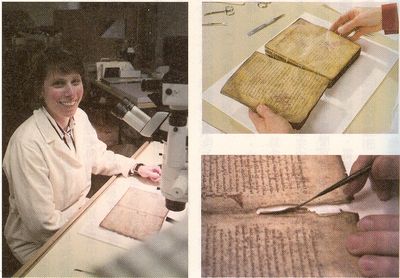Many years ago, in reading “Between Calm and Passion,” a novel co-authored by Kaori Eguni and Jinsei Tsuji, I discovered the “conservator,” a very lonely profession with fascinating stories hidden in the work. The main character, Akagi, said, “I was deeply moved by the techniques of delicately returning a heavily damaged work of art to its original form. For the first time, I realized that there were people who could rescue a gradually dying life.”
As a result, when I heard that there was an "Archimedes Palimpsest" on parchment in the collection of my favorite Walters Art Museum, and that its restoration was completed in 2004, I could not help but wonder who the conservator was? What did this person, with such an important responsibility, look like? How did he restore this book, which was at least 1,040 years old?
During the course of researching the restoration of this book, I discovered an even more fascinating story……
Papyrus v.s. Parchment
During my school days when I was an editor of a campus publication, I learned that there were numerous types of paper. Like fabrics to a designer, or ingredients and spices to a chef, the touch and the visual effect of papers held a appeal to my senses. I especially like cotton tissue paper and rice paper.
When traveling, I often closed my eyes and listened to the rustling of papers around me: the sound of turning a page in a newspaper, of reading a book, of crumpling an advertisement, the sound of a pen scratching the surface of paper…. Reading about how a secret was preserved on papyrus in Dan Brown's "Davinci Code," I immediately thought of the delicate crisp sound of papyrus being crushed to fragments.
Papyrus, the ancestor of all papers, was created 3,000 years before paper was first created in China by Cai Lun. Books on papyrus were always in scrolls, very much the same way court papers in ancient China were and Chinese paintings still are. The "Old Testament" contains about 700,000 to 800,000 words. Written on papyrus, it would probably be longer than the 528 centimeters of the famous Qing Ming River Scene paining. Imagine the amount of time people of long ago spent rolling and unrolling books when they were reading. The Library of Alexandria, founded by Ptolemy I Soter of Egypt, was said to have a collection of 700,000 books, which was an astounding quantity in those ancient times. It is hard to visualize how the books were stored. Were the scrolls stacked on top of each other?
This library had the fame of being the largest library in the world at the time, but it became the second largest when the Library of Pergamon was built. The King of Egypt jealously prohibited the export of papyrus to Greece, thinking that, without paper, the Greeks wouldn't be able to produce books!
As the saying goes, "A dog would climb up a wall when desperate," people too would find a way out when cornered. Without papyrus, the Greeks invented the parchment, which was even better than papyrus.
Animal skin is naturally thicker and more durable than papyrus. Papyrus could not be folded but parchment could. Thus the Greeks invented books using folded parchment bound along the fold. Gone were the days when books had to be laboriously rolled and unrolled, and people could read books by turning the pages.
Three hundred years after the invention of parchment, three people at different times copied the correspondence, principles and drawings of Archimedes onto parchment books. The contents of the three books are similar, and one of them is in the Walters Art Museum.
【to be continued】

|